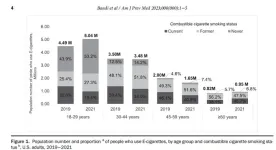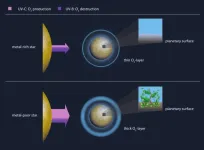(Press-News.org) ABSTRACTS: CT016, CT018
ORLANDO, Fla. ― Researchers from The University of Texas MD Anderson Cancer Center presented promising findings from multiple clinical trials today at the American Association for Cancer Research (AACR) Annual Meeting 2023. The studies, which describe results from a novel FGFR inhibitor and from new PARP/ATR inhibitor combinations, were featured in a plenary session highlighting novel biomarker-driven molecularly targeted therapy trials. Information on all MD Anderson AACR Annual Meeting content can be found at MDAnderson.org/AACR.
Basket trial results suggest wider population may benefit from FGFR inhibitor pemigatinib (Abstract CT016)
The FIGHT-207 trial, led by Jordi Rodon, M.D., Ph.D., associate professor of Investigational Cancer Therapeutics, demonstrated promising early signs of clinical benefit and unveiled potential mechanisms of primary and secondary resistance following treatment with the selective FGFR inhibitor pemigatinib in patients with advanced FGFR-altered solid tumors.
Pemigatinib achieved responses across multiple tumor types, with the highest objective response rate (26.5%) in the cohort containing patients with FGFR1-3 fusions. These include responses in glioblastoma and pancreatic cancers, which were not known to respond to FGFR inhibitors, and patients with previously unreported FGFR alterations.
The researchers also found that certain co-occurring mutations correlated with patient responses. For example, BAP1 mutations were associated with higher response rates, while TP53 alterations were associated with lower response rates.
“This study highlights the value of basket trials as a discovery tool. Instead of grouping by cancer type, this trial grouped cohorts based on types of mutations,” Rodon said. “There remain a lot of unknowns with FGFR inhibitors, with FGFR mutations that drive sensitivity and resistance, and with tumor types where these alterations drive growth. This basket trial allowed us to explore these unknowns from a mutational rather than a histological point of view to see what other types of patients may benefit.”
FGFR alterations drive cancer progression in multiple tumor types, making them a promising target for therapies. However, a lack of target selectivity in first-generation FGFR inhibitors frequently led to intolerable toxicities, limiting their effectiveness in the clinic. Pemigatinib overcomes that by selectively targeting certain FGFR proteins commonly found in cancers; the drug previously was approved by the Food and Drug Administration (FDA) for use in refractory cholangiocarcinoma and myeloid/lymphoid neoplasms (MLNs) with fibroblast growth factor receptor 1 (FGFR1) rearrangement.
The open-label, single-arm Phase II basket study was designed to evaluate the efficacy and safety of pemigatinib in patients with previously treated unresectable or metastatic solid tumors harboring FGFR mutations or fusions/rearrangements. The trial enrolled 111 patients and grouped participants into three cohorts based on the specific type of FGFR alteration. Patients were 56% female with a median age of 62; 56% had more than two prior lines of therapy.
Safety was consistent with previous studies of pemigatinib, with the most common adverse events being hyperphosphatemia, or excess phosphorous in the blood, in 84% of patients, followed by stomatitis (53.2%), alopecia (41%), diarrhea (39%) and constipation (33%.) Of these, only stomatitis (9%) occurred at a grade 3 level or higher in more than 1% of patients.
This trial was supported by Incyte. A full list of authors and their disclosures can be found here.
PARP and ATR inhibitors in combination show promising early results (Abstract CT018)
Two trials led by Timothy A. Yap M.D., Ph.D., associate professor of Investigational Cancer Therapeutics, showed encouraging results for treating solid tumors with DNA damage response alterations using a combination of PARP and ATR inhibitors. Notably, anti-tumor activity was seen in patients with tumors that had previously shown resistance to PARP inhibitors or platinum-based therapies.
The researchers studied combinations of the ATR inhibitor camonsertib with each of three currently approved PARP inhibitors, niraparib, talazoparib and olaparib. The clinical benefit rate (CBR) for all patients in this heavily pretreated population was 48%, with an overall response rate (ORR) of 18% in the niraparib group and 10% in each of the groups treated with talazoparib and olaparib. The high molecular response rate using circulating tumor DNA further confirmed treatment effect and offered a mechanistic explanation for the durable clinical benefit.
The highest response rates were seen in patients with ovarian cancer. Among 19 patients, the ORR was 32% and CBR was 58%, with a median progression-free survival of about seven months and treatment of at least 16 weeks ongoing in nine patients.
“We really need better approaches with PARP inhibitors to maximize their benefit, and pre-clinical data support combinations with ATR inhibitors. This study was designed to evaluate the optimal combination from a tolerability and toxicity standpoint,” Yap said.
PARP inhibitors have been approved for certain cancer types since 2014, but not all patients respond and those that do often build up resistance, limiting their clinical effectiveness. To overcome these problems, researchers studied the effectiveness of combining them with an ATR inhibitor.
ATR inhibitors are similar to PARP inhibitors in that they target the DNA damage repair pathway. In cells with defects in repair pathways, this causes a buildup of cell damage and ultimately cell death. Pre-clinical studies suggest that, since the two work toward the same goal using different mechanisms, the combination of the two makes them more effective than either one alone.
The two Phase I/II trials include a total of 107 patients, with 90 evaluable for efficacy at the time of the AACR data cut off. Patients received a median of three prior lines of therapy, including 39% of patients having previously been treated with a PARP inhibitor and 78% of patients who were platinum-resistant or refractory.
The challenge in bringing these combinations to the clinic has been overcoming the overlapping toxicities associated with both inhibitors. In this trial, both drugs were given at low intermittent doses based on strong pre-clinical modeling data supporting this novel approach.
“Using this dosing technique, we were able to get combinatorial efficacy without the severe toxicity,” Yap said. “We were very excited to see responses even in patients who previously had been treated with a PARP inhibitor and were resistant to it, which is a critical area of unmet need that is urgently required in the clinic.”
In general, the combinations were well tolerated. The most common adverse events were short-term reversible hematological side effects, such as anemia, with no prophylactic growth factors required in the study. Dose optimization in molecularly driven tumor-specific expansion cohorts is ongoing.
This trial was supported by Repare Therapeutics through a strategic collaboration with MD Anderson. A full list of collaborating authors and their disclosures can be found here.
END
AACR: Early trial results show benefits of FGFR inhibitors and PARP/ATR inhibitor combinations in multiple tumor types
AACR: Early trial results show benefits of FGFR inhibitors and PARP/ATR inhibitor combinations in multiple tumor types
2023-04-18
ELSE PRESS RELEASES FROM THIS DATE:
Tiny biobattery with 100-year shelf life runs on bacteria
2023-04-18
BINGHAMTON, N.Y. -- A tiny biobattery that could still work after 100 years has been developed by researchers at Binghamton University, State University of New York.
Last fall, Binghamton University Professor Seokheun “Sean” Choi and his Bioelectronics and Microsystems Laboratory published their research into an ingestible biobattery activated by the Ph factor of the human intestine.
Now, he and PhD student Maryam Rezaie have taken what they learned and incorporated it into new ideas for use outside the body.
A new study in the journal Small, which covers nanotechnology, shares the results from using spore-forming bacteria similar ...
Limited resources leave youth vulnerable to digital abuse
2023-04-18
ITHACA, N.Y. – Youth in the U.S. are targets of cross-platform digital abuse from peers, strangers, offline acquaintances and even relatives, with threats ranging from harassment and sexual violence to financial fraud, according to a new study from Cornell University and Google researchers.
Aided by firsthand accounts, researchers identified the need for more resources to educate youth and parents on digital abuse. They call for better communication and coordination among adult stakeholders in implementing sound protective practices.
“We really need to take a closer look at the types of things that young people are experiencing online, because these experiences ...
In some US schools, 1 in 4 students report misusing prescription stimulants
2023-04-18
U.S. middle and high schools with the most students taking prescription stimulants to treat ADHD also had, overall, the highest percentage of students who misused prescription stimulants within the past year.
The University of Michigan-led study highlights a significant association between ADHD stimulant therapy in schools and prescription stimulant misuse, said Sean Esteban McCabe, U-M professor of nursing and principal investigator on the study.
At some schools, 25% or more of kids reported misusing prescription stimulants in the past year—meaning they used ...
USPSTF statement on screening for skin cancer
2023-04-18
Bottom Line: The U.S. Preventive Services Task Force (USPSTF) concludes that the current evidence is insufficient to assess the balance of benefits and harms of visual skin examination by a clinician to screen for skin cancer in adolescents and adults. Skin cancer is the most commonly diagnosed cancer in the U.S. There are different types of skin cancer varying in disease incidence and severity. Basal and squamous cell carcinomas are the most common types of skin cancer but infrequently lead to death or substantial morbidity. Melanomas represent about 1% of skin cancer and cause the most skin cancer deaths. The USPSTF routinely ...
Association of COVID-19 infection with incident diabetes
2023-04-18
About The Study: In this study of more than 600,000 individuals, SARS-CoV-2 infection was associated with a higher risk of diabetes and may have contributed to a 3% to 5% excess burden of diabetes at a population level.
Authors: Naveed Z. Janjua M.B.B.S, Dr.P.H., of the British Columbia Centre for Disease Control in Vancouver, is the corresponding author.
To access the embargoed study: Visit our For The Media website at this link https://media.jamanetwork.com/
(doi: 10.1001/jamanetworkopen.2023.8866)
Editor’s Note: Please see the article for additional information, including other authors, author contributions ...
Factors associated with knowledge and experience of self-managed abortion among patients seeking care at abortion clinics
2023-04-18
About The Study: In this survey study of 19,000 patients attending 49 abortion clinics in 29 states, considering self-managed abortion was common before accessing in-clinic care, particularly among those on the margins of access or with a preference for at-home care. These findings suggest a need for expanded access to telemedicine and other decentralized abortion care models.
Authors: Abigail R. A. Aiken, Ph.D., of the University of Texas at Austin, is the corresponding author.
To access the embargoed study: Visit our For The Media website at this link https://media.jamanetwork.com/
(doi: ...
School prevalence of stimulant therapy for ADHD associated with higher rates of prescription stimulant misuse among teens
2023-04-18
Researchers have identified a strong association between prevalence of prescription stimulant therapy for attention-deficit/hyperactivity disorder (ADHD) and rates of prescription stimulant misuse (taken in a way other than as directed by a clinician) by students in middle and high schools. The study, which appeared today in JAMA Network Open, highlights the need for assessments and education in schools and communities to prevent medication-sharing among teens. This is especially important considering non-medical use of prescription stimulants among teens remains more prevalent than misuse ...
New research shows e-cigarette use up sharply among younger adults in U.S. during EVALI outbreak and COVID-19 pandemic
2023-04-18
ATLANTA, April 18, 2023 – A new study by researchers at the American Cancer Society (ACS) shows almost three-quarters of a million more adults in the United States, ages 18-29 years, used e-cigarettes between 2019-2021 during the period that spanned the EVALI outbreak (E-cigarette or vaping product use–associated lung injury) and COVID-19 pandemic. Scientists report the year-on-year increase was primarily among adults who never smoked cigarettes. The study was published today in the American Journal of Preventive Medicine (AJPM).
“Unfortunately, these numbers show we’re moving in the wrong direction concerning e-cigarette use in this vulnerable ...
Over half of top selling Medicare drugs have low added therapeutic benefit
2023-04-18
Brand-name drugs cost two to three times more in the U.S. than in other countries, but many of the top-selling brand name drugs may provide little added therapeutic benefit. A new study led by researchers at Brigham and Women’s Hospital, a founding member of Mass General Brigham, used public Medicare data to identify the 50 highest-selling brand-name drugs in 2020. The researchers evaluated their therapeutic benefit compared to existing standards of care, based on ratings from the national health technology assessment (HTA) organizations of Canada, France, and Germany. The team found that 27 of the 50 drugs received ...
Metal-poor stars are more life-friendly
2023-04-18
Stars that contain comparatively large amounts of heavy elements provide less favourable conditions for the emergence of complex life than metal-poor stars, as scientists from the Max Planck Institutes for Solar System Research and for Chemistry as well as from the University of Göttingen have now found. The team showed how the metallicity of a star is connected to the ability of its planets to surround themselves with a protective ozone layer. Crucial to this is the intensity of the ultraviolet light that the star emits into space, in different wavelength ranges. The study provides scientists searching ...
LAST 30 PRESS RELEASES:
iPS cells from dish to freezer and back
Deep neural networks enable accurate pricing of American options under stochastic volatility
Collective risk resonance in Chinese stock sectors uncovered through higher-order network analysis
Does CPU impact systemic risk contributions of Chinese sectors? Evidence from mixed frequency methods with asymmetric tail long memory
General intelligence framework to predict virus adaptation based on a genome language model
Antibiotic resistance is ancient, ecological, and deeply connected to human activity, new review shows
Vapes, pouches, heated tobacco, shisha, cigarettes: nicotine in all forms is toxic to the heart and blood vessels
From powder to planet: University of Modena engineers forge a low-carbon future for advanced metal manufacturing
Super strain-resistant superconductors
Pre-school health programme does not improve children’s diet or physical activity, prompting call for policy changes, study finds
Autumn clock change linked to reduction in certain health conditions
AI images of doctors can exaggerate and reinforce existing stereotypes
Where medicine meets melody – how lullabies help babies and parents in intensive care
We may never be able to tell if AI becomes conscious, argues philosopher
AI video translation shows promise but humans still hold the edge
Deep ocean earthquakes drive Southern Ocean’s massive phytoplankton blooms, study finds
Without campus leftovers to pick through, the beaks of this bird changed shape during the pandemic
High-dose antibiotic does not reduce mortality in tuberculous meningitis
How many insects fly in the sky above the USA?
Could cheese protect your brain health?
Who faces more difficulty recovering from stroke?
Colliding galaxies create the brightest, fastest growing black holes at their center
New BrainHealth research reveals tradeoffs on sleep with cannabis use for chronic pain
Aging-US now on ResearchGate, enhancing visibility for authors and readers
'Molecular glue' stabilizes protein that inhibits development of non-small cell lung cancer
Mount Sinai Health System is recognized in 2025 Chime Digital Health Most Wired survey
From prey to predator: How carnivores spread beneficial fungi
Menopause symptoms may be frequent and have negative effects, according to female endurance athletes
US Congressmembers’ responses on X to mass shooting events differ along party lines
KAIST-UEL team develops “origami” airless wheel to explore lunar caves
[Press-News.org] AACR: Early trial results show benefits of FGFR inhibitors and PARP/ATR inhibitor combinations in multiple tumor typesAACR: Early trial results show benefits of FGFR inhibitors and PARP/ATR inhibitor combinations in multiple tumor types




